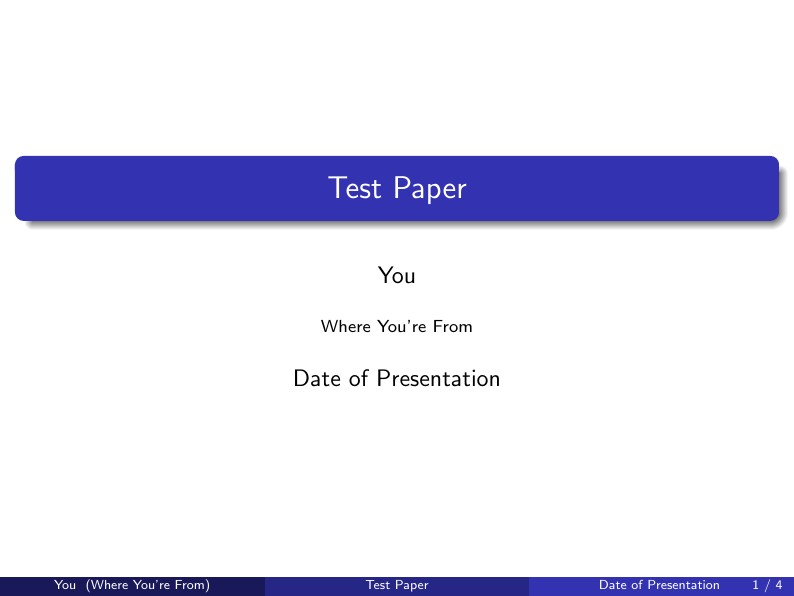
Test Paper
OfficialAuthor:
john.lees-miller+student
Last Updated:
11년 전
License:
Creative Commons CC BY 4.0
Abstract:
Test paper for gallery.

\begin
Discover why over 20 million people worldwide trust Overleaf with their work.

\begin
Discover why over 20 million people worldwide trust Overleaf with their work.
%
% Hello! Here's how this works:
%
% You edit the source code here on the left, and the preview on the
% right shows you the result within a few seconds.
%
% Bookmark this page and share the URL with your co-authors. They
% can edit at the same time!
%
% You can upload figures, bibliographies, custom classes and
% styles using the files menu.
%
% This presentation is made with the Beamer package. For tutorials
% and more info, see:
% http://en.wikipedia.org/wiki/Beamer_(LaTeX)
%
% We're still in beta. Please leave some feedback using the link at
% the top left of this page.
%
% Enjoy!
%
\documentclass{beamer}
%
% Choose how your presentation looks.
%
% For more themes, color themes and font themes, see:
% http://deic.uab.es/~iblanes/beamer_gallery/index_by_theme.html
%
\mode<presentation>
{
\usetheme{Madrid} % or try Darmstadt, Madrid, Warsaw, ...
\usecolortheme{default} % or try albatross, beaver, crane, ...
\usefonttheme{default} % or try serif, structurebold, ...
\setbeamertemplate{navigation symbols}{}
\setbeamertemplate{caption}[numbered]
}
\usepackage[english]{babel}
\usepackage[utf8x]{inputenc}
% On writeLaTeX, these lines give you sharper preview images.
% You might want to comment them out before you export, though.
\usepackage{pgfpages}
\pgfpagesuselayout{resize to}[%
physical paper width=8in, physical paper height=6in]
\title{Test Paper}
\author{You}
\institute{Where You're From}
\date{Date of Presentation}
\begin{document}
\begin{frame}
\titlepage
\end{frame}
% Uncomment these lines for an automatically generated outline.
%\begin{frame}{Outline}
% \tableofcontents
%\end{frame}
\section{Introduction}
\begin{frame}{Introduction}
\begin{itemize}
\item Your introduction goes here!
\item Use \texttt{itemize} to organize your main points.
\end{itemize}
\vskip 1cm
\begin{block}{Examples}
Some examples of commonly used commands and features are included, to help you get started.
\end{block}
\end{frame}
\section{Some \LaTeX{} Examples}
\subsection{Tables and Figures}
\begin{frame}{Tables and Figures}
\begin{itemize}
\item Use \texttt{tabular} for basic tables --- see Table~\ref{tab:widgets}, for example.
\item You can upload a figure (JPEG, PNG or PDF) using the files menu.
\item To include it in your document, use the \texttt{includegraphics} command (see the comment below in the source code).
\end{itemize}
% Commands to include a figure:
%\begin{figure}
%\includegraphics[width=\textwidth]{your-figure's-file-name}
%\caption{\label{fig:your-figure}Caption goes here.}
%\end{figure}
\begin{table}
\centering
\begin{tabular}{l|r}
Item & Quantity \\\hline
Widgets & 42 \\
Gadgets & 13
\end{tabular}
\caption{\label{tab:widgets}An example table.}
\end{table}
\end{frame}
\subsection{Mathematics}
\begin{frame}{Readable Mathematics}
Let $X_1, X_2, \ldots, X_n$ be a sequence of independent and identically distributed random variables with $\text{E}[X_i] = \mu$ and $\text{Var}[X_i] = \sigma^2 < \infty$, and let
$$S_n = \frac{X_1 + X_2 + \cdots + X_n}{n}
= \frac{1}{n}\sum_{i}^{n} X_i$$
denote their mean. Then as $n$ approaches infinity, the random variables $\sqrt{n}(S_n - \mu)$ converge in distribution to a normal $\mathcal{N}(0, \sigma^2)$.
\end{frame}
\end{document}